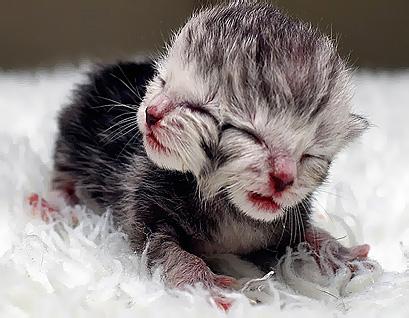This is the second part of a comprehensive 3-part series on radiation that is being published on BNC in weekly instalments during November 2013. This week, we look at… mutations!
———-

Is this caused by radiation exposure, or…?
Guest Post by Geoff Russell. Geoff is a computer programmer, vegan, environmentalist, and more generally, a ‘by-the-numbers’ polymath. For a list of all of his posts on BNC, click here. He also has collections here and here.
Part I noted the extraordinary levels of radiation needed to cause similar levels of damage to normal (non-radiation) processes. But evolution has produced some horrors which can slice and dice DNA far worse than a mere 200,000 times the natural level of background radiation.
I’ll see your 200,000 and raise it 10 times!
People with a rare disease called Bloom’s syndrome experience about 10 times the normal level of double strand breaks. That’s like the DNA damage from 2 million times normal background radiation.
Genetic diseases have been around near enough to forever. In particular, Bloom’s looks to be at least a couple of thousand years old. Some mutations in the BRCA1 gene, one of which was given global fame recently by Angelina Jolie, probably originated about 1800 years ago. One million Japanese carry a mutation set which could give an unlucky child 10,000 times the risk of skin cancer (xeroderma pigmentosum). This charming little evolutionary gift is also thousands of years old. Cystic fibrosis goes back at least to the iron age. People with all these mutations have thus far managed to leave enough children to offset any tendencies of natural selection to bar them from the gene pool.
While these diseases, and thousands of others like them, have shortened lives and caused immense suffering for a very long time, none were caused by a nuclear accident or war. And it should now be obvious why no nuclear accident or war could possibly create as many double strand breaks as people with Bloom syndrome experience.
And there’s a new kid on the block
The really big news on genetic disease that has emerged during the past decade or two is not only that radiation accidents are obviously innocent bystanders to the thousands of known genetic diseases, but that you don’t even need mutations to produce a genetic disease. And if you don’t need mutations, then you don’t need double strand or any other kind of DNA damage. And when it comes to cancer, you don’t even need carcinogens in the normal meaning of the word.
It’s kind of obvious when you think about it. The cells in both your brains and your biceps have exactly the same DNA but operate very, very differently. There has to be a way of turning off genes that make muscle body proteins in your brain and vice-a-versa in your biceps. There really have to be ways of turning on and off any and every gene in every cell in your body. And there are.

Massive DNA damage, caused by exposure to… milk. Click on the image for details, in Geoff Russell’s post “Would sir like a caesium salad with his steak?”
Molecular genetics has long studied regulatory mechanisms within DNA, but over the last 20 years various new classes of mechanism have been discovered which have spawned a sub-branch of genetics called epigenetics. Part III will explain the connection between epigenetics and cancer, but the one sentence preview is that science is now starting to understand causes of cancer and other diseases beyond mutations and some are incredibly mundane. But that’s for later.
Mutant myths
The notion that atomic bombs are somehow worthy of some special horror status relative to conventional bombs because of their radiation is usually coupled with ignorance about birth defects. Greenpeace is one of many organisations who seem to think that the appearance of “birth defects” and “nuclear power” in the same sentence is all you need to establish a causal link. ABC journalist Greg Hoy used the same causal sleight of hand in a recent story about a uranium enrichment technology. He claimed that a large rise in horrific birth defects in Fallujah in Iraq were the after-effects of using bombs encased in depleted uranium (which is less radioactive then normal uranium … “depleted” being a bit of a hint). His evidence? None. The before-effects didn’t rate a mention in Hoy’s story. Bombs, whether encased in depleted uranium or something else, kill, cripple, crush and burn. They destroy lives, property and hope. But Hoy’s focus was on the one thing that they don’t do … cause a massive and prolonged surge in birth defects.
The fact that Hoy thought he didn’t need evidence for the connection demonstrates an intellectual bloodline running back to the anti-nuclear hyperbole that began shortly after the World War II bombings of Hiroshima and Nagasaki and further puffed up by Chernobyl mythology.

You really owe it to yourself to read this book before you wax lyrical about what radiation is, and what it does and doesn’t do.
A recent book by Robert Gale and Eric Lax on radiation deals with the issues in some detail. Gale is a Professor with his name on 823 scientific papers, which is 823 more than anti-nuclear guru Helen Caldicott and also 823 more than Greg Hoy or any of the people he selected for his story. Gale was called in to treat the Chernobyl firefighters and has been at most radiation accidents of any magnitude over the past few decades. Here’s a quick summary of his assessment of the connection between radiation and birth defects.
Of some 3,000 pregnant women who survived the Hiroshima or Nagasaki blasts, 30 had infants with micrencephaly (small heads and mild to moderate retardation). That’s it. The current South Australian rate of micrencephaly would see 2 to 3 children in that sized group, so 30 was tragic, certainly, but vastly less tragic than the conventional bombing of Tokyo which killed far more people and left far more suffering. It’s also vastly less tragic than the atomic bombings themselves. It is simply not the stuff of mumbling mutant radiation wasteland horror films. The worst effected of the children of these 30 women were from mothers who received about 400 years worth of background radiation from the blast. Children of women who only got a mere 120 years worth had no problems.
The surviving women who weren’t pregnant at the time have gone on to have families and the birth defect rates in the tens of thousands of children subsequently born to those women is normal. The children of these women have been well studied and their health status is normal also.
And at Chernobyl?
There was a flood of dead fetuses. Not because of radiation, but through blind fear, panic and ignorance.
Imagine being a pregnant Iraqi woman in any area which had ever been subjected to US bombing and watching the sad and gruesome images in Greg Hoy’s story? The only choice left would be one between the coat hanger or the knitting needles as your instrument of termination.
Gale puts the number of unnecessary abortions after Chernobyl at about 100,000. These and any ensuing psychological trauma are a legacy of radiation ignorance picked up and fanned by anti-nuclear campaigners. No women at Chernobyl received anything like the amount of radiation needed to harm a growing fetus. It was only the firefighters in the front line who received heavy doses and none happened to be pregnant. Consequently, nearly 30 firefighters died, but not just from radiation, they also died from exactly the same kinds of injuries that killed 119 US firefighters in the same year.
One of the surviving firefighters was Andrei Tarmosian, 25 years old at the time. Gale and his team saved Andrei’s life and subsequently he and Gale kept in touch. But popular myths trumped ready access to the judgement of one of the best radiation experts on the planet. Tarmosian believed that his radiation exposure doomed him to cancer. He also believed the Russian urban legend that vodka was protective against radiation. This potent mix of fear and nonsense saw him die in 2010, aged 50, of cirrhosis of the liver. He was collateral damage, like all those aborted fetuses and the women who aborted them, of wide-spread radiation ignorance.

Statue commemorating the efforts of the fire fighters and liquidators at the Chernobyl Nuclear accident.
Proof by shocking image
It’s not hard in any moderate sized population of people or other animals to find a bunch of birth defects to construct a journalistic “proof by photograph” case. All you need is ignorance coupled with will. The rate of birth defects in South Australia currently is about 4.5 percent. In the US, they categorise about 2-3 percent of births as having major malformations with another 10 percent having internal anomalies and functional problems that only become apparent later in life. Each year, South Australia’s 4.5 percent amounts to about 1,000 infants. There are many rare conditions with long names and serious consequences in addition to the more common things with serious consequences which people may have come into contact with or read about, like micrencephaly, Down syndrome and chromosomal defects. There are perhaps 200 infants with hearts malformed in various ways. So, work it out. How many tens of thousands of birth defects should you expect annually in a country like Ukraine with its population of 50 million in the late 1980s? How hard would it have been to find a dozen or a hundred for a photo shoot?
Just because you can find birth defects and photograph them doesn’t mean you know what caused them. The breakdown in the Soviet health system with the dismantling of the Soviet Union saw all kinds of disease rates rise. The ignorance that saw Ukrainians rely on vodka to protect them from radiation is the same kind that sees radiation behind every untoward health issue, particularly birth defects.
Apart from sending superstitious firefighters to an early grave what else might vodka do? Microcephaly for one. Apart from surviving an atomic bomb at close quarters, the list of things that can cause microcephaly includes not only alcohol, but also various drugs and viruses. The viruses include measles and chicken pox. Another effective method is untreated phenylketonuria (a genetic disorder).
Birth defects are depressingly easy to produce
Nobody knows what causes most birth defects, partly because there are so many potential and mundane causes.
Nobody deliberately causes birth defects in people, but animals aren’t so lucky. Scientists certainly didn’t stop with fruit flies after the work of Hermann Muller. They’ve been producing mutant animals of many species for decades. How do they do it? A comprehensive list of methods would be long. You can, of course, use massive doses of radiation, or hydrogen peroxide, or lead, or mercury or Vitamin A, but if your budget is tight and you have a taste for the mundane, a heat lamp or electric blanket will do the job. It’s all in the timing. Just raise the core body temperature of your chosen animal by a few degrees at just the right time and bingo you can produce the full gamut of neural tube defects and so much more. Microphthalmia (small eyes), cataract, coloboma (hole in the eye), cross eyes, underdevelopment of teeth and toes, exomphalos (intestines or other organs outside of the body at birth), renal agenesis (missing kidney(s)), club foot, disturbances of muscle tone, arthrogyposis (curving joints). And of course, you can produce the same micrencephaly (small head/brain) which radiation caused in the children of those 30 atomic bomb survivors.
How else can core body temperatures be raised? Influenza or anything that produces a fever may do it and the subsequent raised core body temperature is capable of producing almost the full range of birth defects. So, for example, consider the 2009 Swine Flu pandemic. It was a little different from normal seasonal flu because it hit and killed many more young people. It’s total global death toll was about 284,000 people. And was there an increase in birth defects after the pandemic? Yes. A UK study found that congenital anomalies roughly doubled. But evolutionary mechanisms favour more draconian steps to reduce such events, so the number of deaths before, during or shortly after delivery increased by factors between three and six, depending on the precise medical category. Other outcomes which would once have resulted in an early death are now handled routinely with professional help: very low birth weights, premature delivery, doubling of cesarean requirements. This was a smallish study confined to women hospitalised with confirmed swine flu. The toll in countries without good health care to handle premature births can be estimated to be considerably higher and the full global toll would be horrific. Researchers similarly found an increase in birth defects after the 1958 flu pandemic.
Now check the daily maximum temperature in Iraq during the summer months and ask yourself if the women of Iraq understand the serious risks of birth defects following a raised core body temperature during pregnancy or an illness with a fever. Ask if intermittent electricity and standing in line for water and other of life’s basic needs would help.
N.B. I’m not asserting a causal link between the Fallujah birth defects and Iraq’s high summer temperatures, I’m trying to explain why working out causal links in the presence of plenty of truly viable alternatives is very tough science. It’s well beyond the remit of documentary film makers and almost all medical doctors. Very few doctors have the requisite statistical skills and most are just as prone to dodgy inductions as everybody else.
Some good news … environmental teratogens are transient
Everybody is right to be worried about the impacts of pandemic influenza and a future with much higher temperatures, but should you be concerned about their impacts on our precious “germ plasm”?
Almost certainly not.
This is because, despite the discovery of numerous environmental teratogens like heat, vitamin A, thalidomide, and numerous other substances, both natural and artificial, the current state of knowledge from professionals who study such matters is that:
To date, genetically mediated malformations have not been found to result from exposure to any environmental agents, even those agents that have been shown to be capable of causing damage to genetic material in individual cells (mutagen).
Put simply, environmental teratogens (things outside your body) can certainly harm or kill a developing fetus, but to date, none have ever been found to produce new mutations which will plague humans long into the future like the ancient BRCA1 mutation or that involved in Bloom’s syndrome. More such horrors may appear, but they’ll be down to horrible luck and the workings of mother nature. The extended text following the above quote singled out radiation as having failed to do precisely this despite the high exposures seen during the atomic bombings of Japan.
It’s time our film makers retired the radiation induced mumbling mutant monster genre. We have plenty of real reasons for concern, plenty of real reasons to act. We don’t need to make stuff up … particularly when these made up fantasies impede the kind of real and effective actions we need to take for a better future, not just for ourselves, but for all the species with which we share this planet.
Nuclear power’s contribution to human health has been overwhelmingly positive for four decades. It has prevented at least 1.8 million premature deaths by producing clean energy to displace the toxic by-products of fossil fuel based electricity. It could have prevented more if sci had prevailed over fi. But it didn’t. The good news is that fighting climate change denial should allow people to see how much it shares with the anti-nuclear movement. But education is a slow process and we don’t have much time. As the German experiment with renewable energy staggers from one failure to the next, nuclear has firmed not only as the most environmentally friendly energy technology we have, but also as the only technology with a hope in hell of being rolled out fast enough to help prevent further destabilisation of the climate.
Part III will be devoted to doing my best to make the science of cancer clearer for people without formal training. It’s the third gen in the trilogy of mutagen, teratogen, carcinogen.
Let’s just end this with a quick quiz. The image below shows a horribly deformed pigeon with it’s spine curved double such that it’s head lies on its back. The bird was produced by scientists during a piece of research and the obvious question might be why wasn’t it killed at birth? Why did they let the poor creature live? Can you guess the cause of this deformity? What chemical or type of radiation at what dose?
Any ideas?
Few readers will know the answer and I doubt any guess would get close to the truth. Mine certainly didn’t.
I must confess that I lied in the interests of illustrating how easy it is to mislead people with horrible pictures and a story they are primed to believe.
The pigeon wasn’t born with a birth defect at all. The poor bird has simply been fed a diet of white rice for a couple of weeks and as a consequence has a vitamin B deficiency. Here’s the same bird a few hours after a vitamin injection.
———-
Got a Comment?
To leave your comment and read other reactions, please go to the dedicated Discussion Thread on the BNC Forums:
http://bravenewclimate.proboards.com/thread/435/stayin-alive-gene-pool-series


Pingback: Stayin’ alive in the gene pool – Part II – The News Doctors